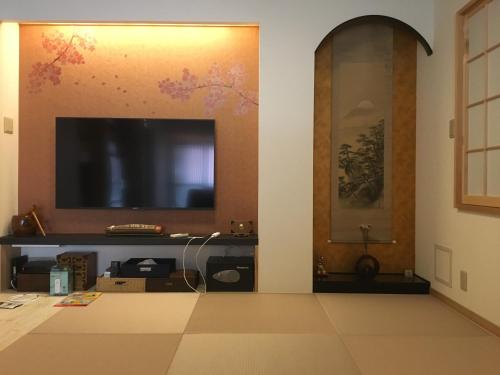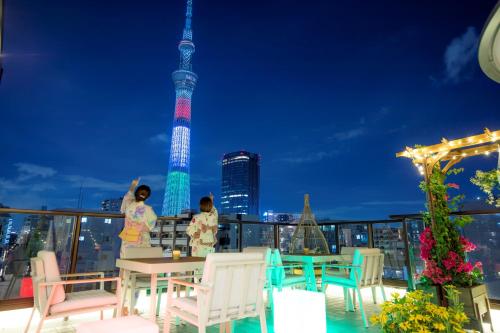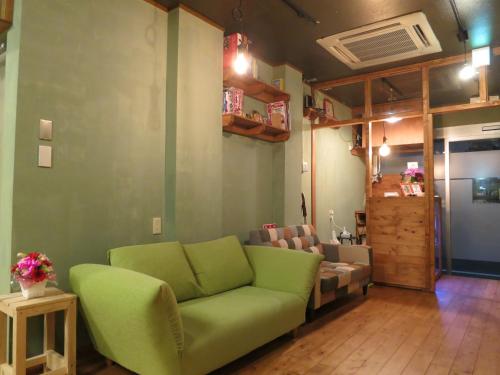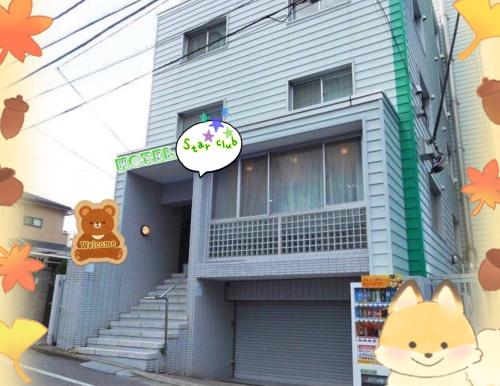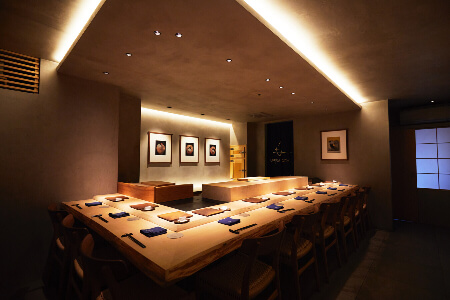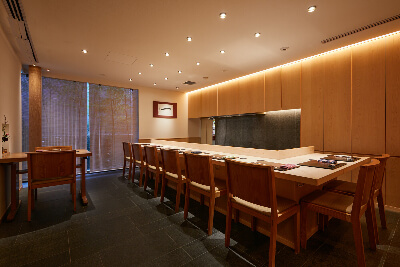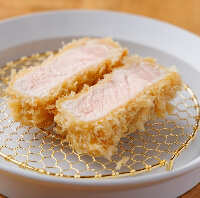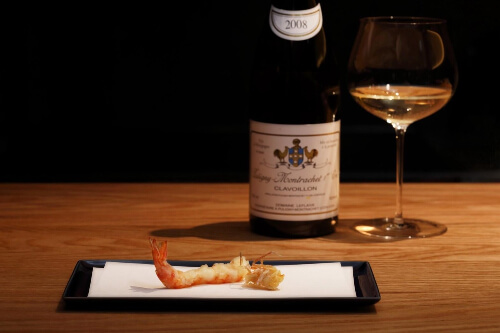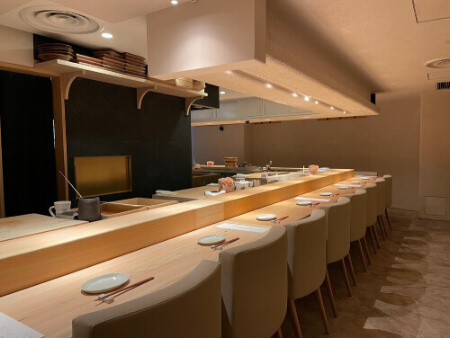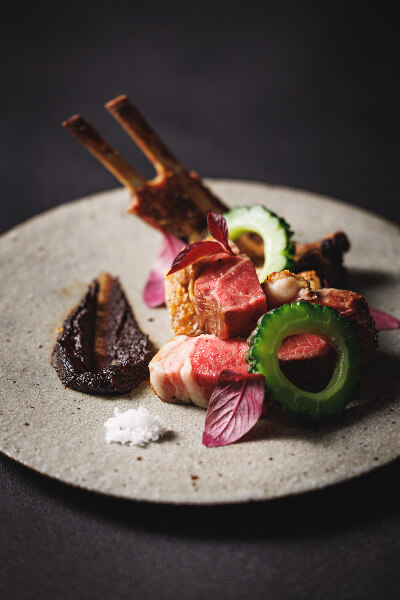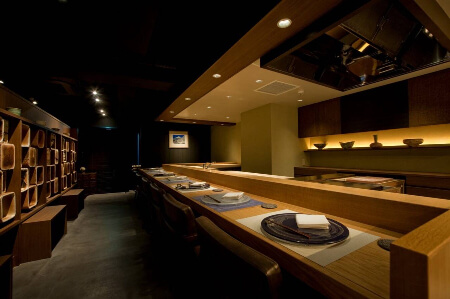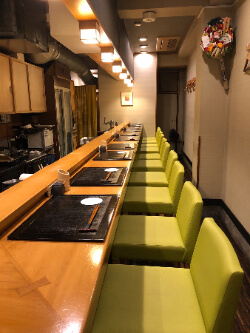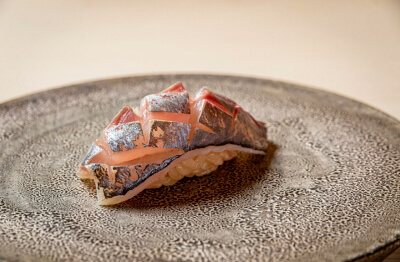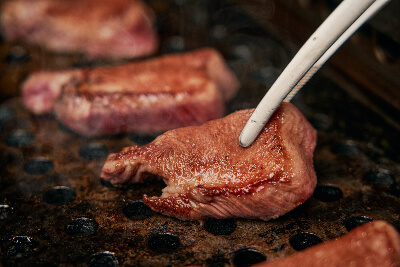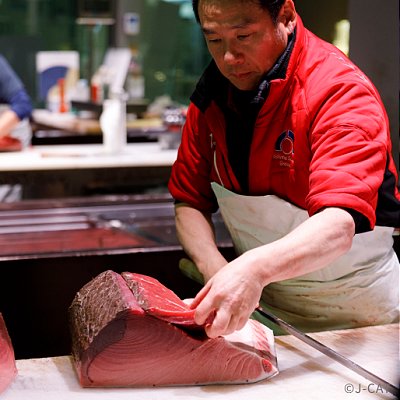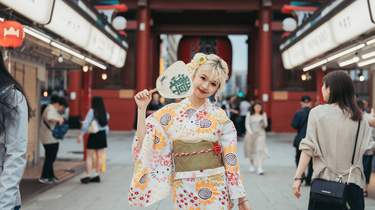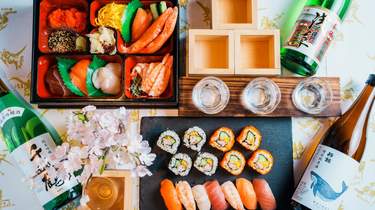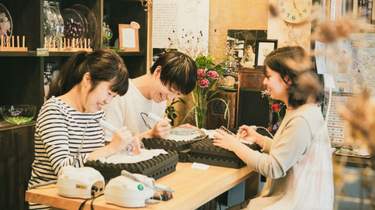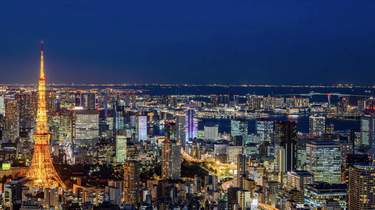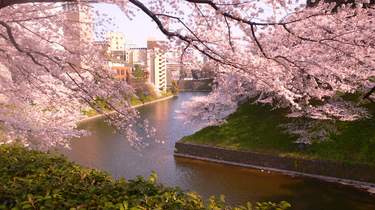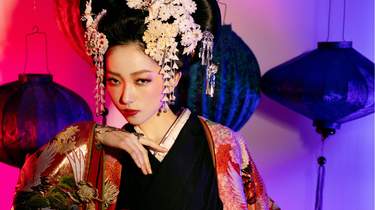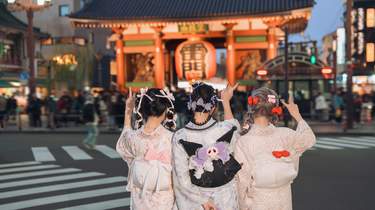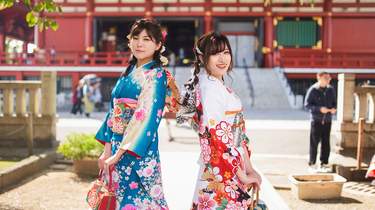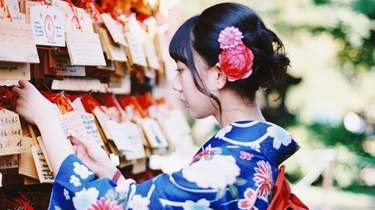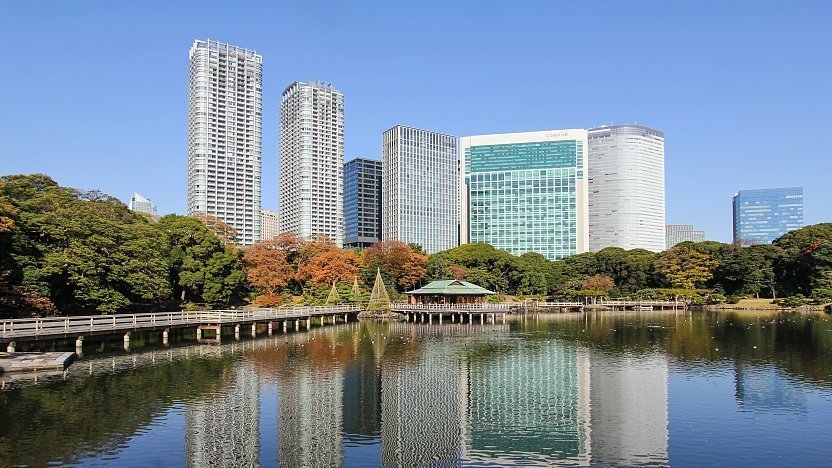
Hama Rikyu (ĢlŚŻŗ{, Hama Rikyū), is a large, attractive landscape garden in central Tokyo. Located alongside Tokyo Bay, Hama Rikyu features seawater ponds which change level with the tides, and a teahouse on an island where visitors can rest and enjoy the scenery. The traditionally styled garden stands in stark contrast to the skyscrapers of the adjacent Shiodome district.
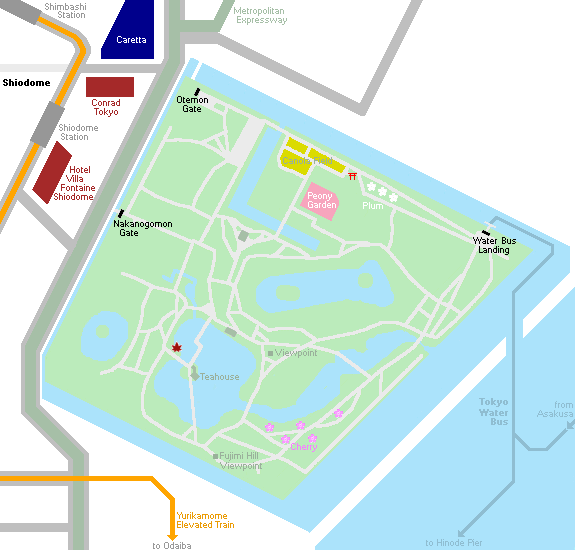
The garden has served many purposes over the centuries. It was originally built as a feudal lord's Tokyo residence and duck hunting grounds during the Edo Period (1603-1867), but later served as a strolling garden and as an imperial detached palace before eventually being opened to the public in its current form. Vestiges of these old roles are still visible throughout the garden including several reconstructed duck hunting blinds and the remains of an old moat and reconstructed rock wall.

Hama Rikyu is attractive in any season. Although not as famous for its fall foliage as some of the other gardens around Tokyo, it offers plenty of maple, ginkgo and other trees that show their beautiful autumn colors between late November and early December.
Late February brings plum blossoms, while the spring cherry blossom season from late March to early April is also nice but somewhat subdued compared to other hanami spots in the city. Several other species of flowers bloom in spring including fields of peony and canola blossoms.
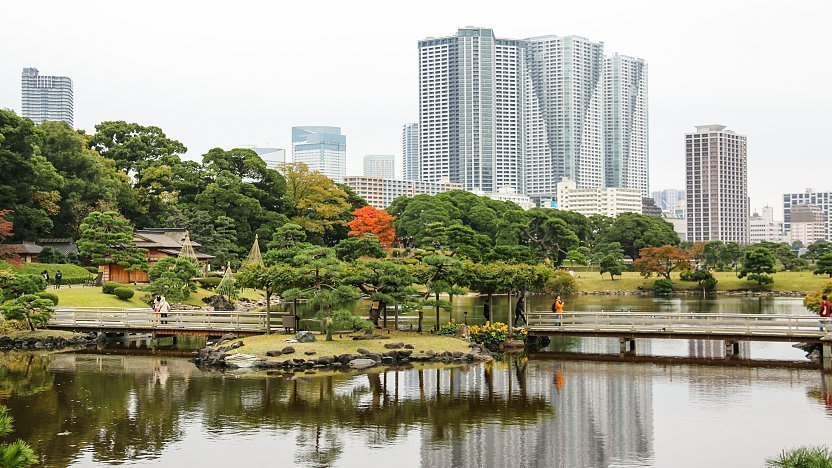
Getting there and around
Hama Rikyu is a 10-15 minute walk from JR Shimbashi Station or a 5-10 minute walk from Shiodome Station on the Oedo Subway Line and the Yurikamome elevated train.
Hama Rikyu can also be accessed from Asakusa by a small number of Tokyo Water Buses (35 minutes, 1180 yen one way including admission into the garden), but note that the water buses do not stop at Hama Rikyu in the opposite direction, and that it is currently not possible to board boats at Hama Rikyu. It is only possible to get off.
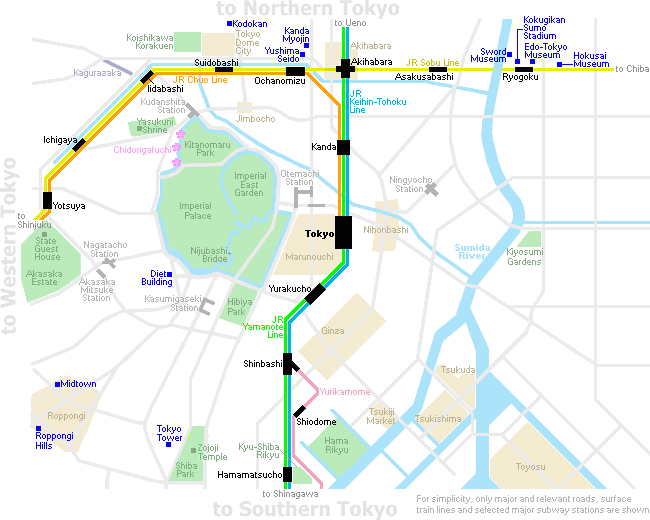
Hours and Fees
Hours
Closed
Admission
Questions? Ask in our forum.
Links and Resources
Hotels around Tokyo
-
-
![]() MokkoanFeaturing free WiFi and a hot tub, Mokkoan offers accommodation in Kita Ward, Tokyo. Private parking is available on site. Every room comes with a flat-screen TV with cable channels. Certain units have a seating area where you can relax. For your comfort, you will find slippers and free toiletries. You will find a shared kitchen at the property. The guest house also offers free use of bicycles. Yokohama is 37 km from Mokkoan, while Chiba is 41 km away. The nearest airport is Tokyo Haneda International Airport, 24 km from Mokkoan.View on Booking.com
MokkoanFeaturing free WiFi and a hot tub, Mokkoan offers accommodation in Kita Ward, Tokyo. Private parking is available on site. Every room comes with a flat-screen TV with cable channels. Certain units have a seating area where you can relax. For your comfort, you will find slippers and free toiletries. You will find a shared kitchen at the property. The guest house also offers free use of bicycles. Yokohama is 37 km from Mokkoan, while Chiba is 41 km away. The nearest airport is Tokyo Haneda International Airport, 24 km from Mokkoan.View on Booking.com -
![]() Tokyo inn Sakura AnSet in Tokyo, 200 metres from Tokyo Origami Museum and 600 metres from Komagatado, Tokyo inn Sakura An offers free bikes and air conditioning. Among the facilities at this property are a 24-hour front desk and full-day security, along with free WiFi throughout the property. The ryokan also offers facilities for disabled guests. The ryokan is equipped with a satellite flat-screen TV. The kitchen is fitted with an oven, a microwave and a toaster and there is a private bathroom with slippers and a hair dryer. For added privacy, the accommodation has a private entrance and soundproofing. Popular points of interest near the ryokan include Chiisanagarasunohonno Museum, Asakusa Station and Sumida Riverside Hall. Tokyo Haneda Airport is 22 km away.View on Booking.com
Tokyo inn Sakura AnSet in Tokyo, 200 metres from Tokyo Origami Museum and 600 metres from Komagatado, Tokyo inn Sakura An offers free bikes and air conditioning. Among the facilities at this property are a 24-hour front desk and full-day security, along with free WiFi throughout the property. The ryokan also offers facilities for disabled guests. The ryokan is equipped with a satellite flat-screen TV. The kitchen is fitted with an oven, a microwave and a toaster and there is a private bathroom with slippers and a hair dryer. For added privacy, the accommodation has a private entrance and soundproofing. Popular points of interest near the ryokan include Chiisanagarasunohonno Museum, Asakusa Station and Sumida Riverside Hall. Tokyo Haneda Airport is 22 km away.View on Booking.com -
![]() SOLA HOTELFeaturing 3-star accommodation, SOLA HOTEL is located in Tokyo, 300 metres from Kamejimashogakko Memorial Park and 800 metres from Kameido Tenjin Shrine. Among the facilities at this property are a lift and full-day security, along with free WiFi throughout the property. The aparthotel features family rooms. The aparthotel will provide guests with air-conditioned units with a wardrobe, a kettle, a microwave, a fridge, a safety deposit box, a flat-screen TV and a private bathroom with a bidet. There is also a well-fitted kitchen in some of the units equipped with an oven and toaster. At the aparthotel, every unit has bed linen and towels. Popular points of interest near the aparthotel include Umeyashiki Monument, Tokyo Skytree and Tobacco & Salt Museum. Tokyo Haneda Airport is 21 km away.View on Booking.com
SOLA HOTELFeaturing 3-star accommodation, SOLA HOTEL is located in Tokyo, 300 metres from Kamejimashogakko Memorial Park and 800 metres from Kameido Tenjin Shrine. Among the facilities at this property are a lift and full-day security, along with free WiFi throughout the property. The aparthotel features family rooms. The aparthotel will provide guests with air-conditioned units with a wardrobe, a kettle, a microwave, a fridge, a safety deposit box, a flat-screen TV and a private bathroom with a bidet. There is also a well-fitted kitchen in some of the units equipped with an oven and toaster. At the aparthotel, every unit has bed linen and towels. Popular points of interest near the aparthotel include Umeyashiki Monument, Tokyo Skytree and Tobacco & Salt Museum. Tokyo Haneda Airport is 21 km away.View on Booking.com -
![]() hanareSet in the Taito district in Tokyo, hanare offers 2-star rooms with free WiFi. The property has quiet street views and is 400 metres from Asakura Museum of Sculpture and 400 metres from Kyoouji Temple. The accommodation offers luggage storage space and a concierge service for guests. Guests at the guest house can enjoy a continental or an Asian breakfast. There is a coffee shop on-site. Guests at hanare will be able to enjoy activities in and around Tokyo, like walking tours. Popular points of interest near the accommodation include The Site of Koda Rohan House, Tenno-ji Temple Gojuno Tower Remains and Tennoji Temple. Tokyo Haneda Airport is 25 km from the property.View on Booking.com
hanareSet in the Taito district in Tokyo, hanare offers 2-star rooms with free WiFi. The property has quiet street views and is 400 metres from Asakura Museum of Sculpture and 400 metres from Kyoouji Temple. The accommodation offers luggage storage space and a concierge service for guests. Guests at the guest house can enjoy a continental or an Asian breakfast. There is a coffee shop on-site. Guests at hanare will be able to enjoy activities in and around Tokyo, like walking tours. Popular points of interest near the accommodation include The Site of Koda Rohan House, Tenno-ji Temple Gojuno Tower Remains and Tennoji Temple. Tokyo Haneda Airport is 25 km from the property.View on Booking.com -
![]() No Borders HostelIn the Shinagawa Ward district of Tokyo, close to Togoshi-ginza Shopping Street, No Borders Hostel features free bikes and a washing machine. Featuring a shared lounge, the guest house is close to several noted attractions, around 1.5 km from Meguro Fudoson Ryusen-ji Temple, 1.6 km from Yakushi-ji Tokyo Annex Temple and 1.7 km from Ohsaki New City Shopping Mall. The accommodation provides a shared kitchen and luggage storage space for guests. The air-conditioned units have a fully equipped kitchen with dining area, a microwave, kettle, and a fridge. Featuring a shared bathroom with a shower and slippers, units at the guest house also offer free WiFi. The units are equipped with heating facilities. Popular points of interest near the guest house include Anyo-in Temple, Remy Gotanda Shopping Mall and Musashi Koyama Shopping Street Palm. Tokyo Haneda Airport is 12 km away.View on Booking.com
No Borders HostelIn the Shinagawa Ward district of Tokyo, close to Togoshi-ginza Shopping Street, No Borders Hostel features free bikes and a washing machine. Featuring a shared lounge, the guest house is close to several noted attractions, around 1.5 km from Meguro Fudoson Ryusen-ji Temple, 1.6 km from Yakushi-ji Tokyo Annex Temple and 1.7 km from Ohsaki New City Shopping Mall. The accommodation provides a shared kitchen and luggage storage space for guests. The air-conditioned units have a fully equipped kitchen with dining area, a microwave, kettle, and a fridge. Featuring a shared bathroom with a shower and slippers, units at the guest house also offer free WiFi. The units are equipped with heating facilities. Popular points of interest near the guest house include Anyo-in Temple, Remy Gotanda Shopping Mall and Musashi Koyama Shopping Street Palm. Tokyo Haneda Airport is 12 km away.View on Booking.com -
![]() Ryokan NakadayaSituated in Tokyo, within 1.5 km of Sensoji Temple and 2.2 km of Tokyo Skytree, Ryokan Nakadaya offers accommodation with a shared lounge. The property is set 3.5 km from Edo Tokyo Museum, 6 km from Marunouchi Building and 6 km from Yasukuni Shrine. Free WiFi is available. The units in the inn are equipped with a flat-screen TV. Each room is equipped with a shared bathroom. The nearest airport is Tokyo Haneda International Airport, 19 km from the property.View on Booking.com
Ryokan NakadayaSituated in Tokyo, within 1.5 km of Sensoji Temple and 2.2 km of Tokyo Skytree, Ryokan Nakadaya offers accommodation with a shared lounge. The property is set 3.5 km from Edo Tokyo Museum, 6 km from Marunouchi Building and 6 km from Yasukuni Shrine. Free WiFi is available. The units in the inn are equipped with a flat-screen TV. Each room is equipped with a shared bathroom. The nearest airport is Tokyo Haneda International Airport, 19 km from the property.View on Booking.com -
![]() Sumida NagayaSet within 600 metres of Hatonomachidori Shopping Street and 700 metres of The Seiko Museum, Sumida Nagaya offers rooms with air conditioning and a shared bathroom in Tokyo. With free WiFi, this 2-star guest house offers a shared kitchen and full-day security. The accommodation features luggage storage space and a housekeeping service for guests. At the guest house, the units are fitted with a desk. The units feature a shared bathroom, slippers and bed linen. The modern restaurant at the guest house serves international cuisine, and is open for dinner and lunch. Guests can also relax in the shared lounge area. Popular points of interest near Sumida Nagaya include Tobu Museum, Aizome Museum and Tsukada Kobo. Tokyo Haneda Airport is 22 km away.View on Booking.com
Sumida NagayaSet within 600 metres of Hatonomachidori Shopping Street and 700 metres of The Seiko Museum, Sumida Nagaya offers rooms with air conditioning and a shared bathroom in Tokyo. With free WiFi, this 2-star guest house offers a shared kitchen and full-day security. The accommodation features luggage storage space and a housekeeping service for guests. At the guest house, the units are fitted with a desk. The units feature a shared bathroom, slippers and bed linen. The modern restaurant at the guest house serves international cuisine, and is open for dinner and lunch. Guests can also relax in the shared lounge area. Popular points of interest near Sumida Nagaya include Tobu Museum, Aizome Museum and Tsukada Kobo. Tokyo Haneda Airport is 22 km away.View on Booking.com -
![]() The Okura TokyoComposed of 2 buildings, The Okura Tokyo boasts a garden and bar. Among the facilities of this property are a restaurant, a 24-hour front desk and room service, along with free WiFi. The accommodation features a concierge, ticket service and currency exchange for guests. All rooms are fitted with air conditioning, a fridge, kettle and flat-screen TV with satellite channels. All guest rooms have a private bathroom with a bath, hairdryer, bidet and free toiletries. Located on 28-40 floors, Prestige Tower offers rooms with cityscape views. Guests booking room type with Club Lounge Access in Heritage Wing can enjoy Club Lounge. Spacious rooms in Heritage Wing include complimentary welcome drink, steam sauna and spa bath. Guests at the hotel can enjoy a buffet breakfast. Popular points of interest near The Okura Tokyo include Iino Hall and Conference Centre, National Diet Building and Space FS Shiodome. The nearest airport is Tokyo Haneda International, 22 km from the hotel, and the property offers a paid airport shuttle service.View on Booking.com
The Okura TokyoComposed of 2 buildings, The Okura Tokyo boasts a garden and bar. Among the facilities of this property are a restaurant, a 24-hour front desk and room service, along with free WiFi. The accommodation features a concierge, ticket service and currency exchange for guests. All rooms are fitted with air conditioning, a fridge, kettle and flat-screen TV with satellite channels. All guest rooms have a private bathroom with a bath, hairdryer, bidet and free toiletries. Located on 28-40 floors, Prestige Tower offers rooms with cityscape views. Guests booking room type with Club Lounge Access in Heritage Wing can enjoy Club Lounge. Spacious rooms in Heritage Wing include complimentary welcome drink, steam sauna and spa bath. Guests at the hotel can enjoy a buffet breakfast. Popular points of interest near The Okura Tokyo include Iino Hall and Conference Centre, National Diet Building and Space FS Shiodome. The nearest airport is Tokyo Haneda International, 22 km from the hotel, and the property offers a paid airport shuttle service.View on Booking.com -
![]() Hotel Yuni Star-ClubLocated within 1.3 km of Sotobori Park and 1.1 km of Museum of Science Tokyo University of Science, Hotel Yuni Star-Club provides rooms with air conditioning and a private bathroom in Tokyo. The property is situated 1.4 km from Shinjuku Historical Museum, 1.4 km from Kosho-ji Temple and 1.2 km from Nanzo-in Temple. The property is non-smoking and is set 1.2 km from Kagurazaka Wakamiya Hachiman Shrine. At the hotel, each room has a wardrobe. Featuring a private bathroom with a shower and free toiletries, rooms at Hotel Yuni Star-Club also offer free WiFi, while selected rooms are fitted with a city view. Guest rooms in the accommodation are equipped with a TV and a hairdryer. Popular points of interest near Hotel Yuni Star-Club include Rentaro Taki Residence Mark Monument, Ichigaya Kinenkan and Shimmichi Shopping Street. Tokyo Haneda Airport is 23 km away.View on Booking.com
Hotel Yuni Star-ClubLocated within 1.3 km of Sotobori Park and 1.1 km of Museum of Science Tokyo University of Science, Hotel Yuni Star-Club provides rooms with air conditioning and a private bathroom in Tokyo. The property is situated 1.4 km from Shinjuku Historical Museum, 1.4 km from Kosho-ji Temple and 1.2 km from Nanzo-in Temple. The property is non-smoking and is set 1.2 km from Kagurazaka Wakamiya Hachiman Shrine. At the hotel, each room has a wardrobe. Featuring a private bathroom with a shower and free toiletries, rooms at Hotel Yuni Star-Club also offer free WiFi, while selected rooms are fitted with a city view. Guest rooms in the accommodation are equipped with a TV and a hairdryer. Popular points of interest near Hotel Yuni Star-Club include Rentaro Taki Residence Mark Monument, Ichigaya Kinenkan and Shimmichi Shopping Street. Tokyo Haneda Airport is 23 km away.View on Booking.com -
![]() Kaminarimon RyokanIdeally set in the centre of Tokyo, Kaminarimon Ryokan offers Asian breakfast and free WiFi throughout the property. Popular points of interest nearby include Hozomon Gate, Nitenmon Gate and Asakusa ROX Shopping Center. The property is non-smoking and is set 300 metres from Asakusa Public Hall. The hotel will provide guests with air-conditioned rooms with a desk, a coffee machine, a fridge, a safety deposit box, a flat-screen TV and a private bathroom with a shower. The rooms come with a kettle, while selected rooms also feature a terrace and others also feature city views. At Kaminarimon Ryokan, the rooms include a seating area. Languages spoken at the reception include English and Japanese, and guests are invited to request information on the area when needed. Popular points of interest near the accommodation include Drum Museum, Komagatado and Asakusa Station. Tokyo Haneda Airport is 22 km from the property.View on Booking.com
Kaminarimon RyokanIdeally set in the centre of Tokyo, Kaminarimon Ryokan offers Asian breakfast and free WiFi throughout the property. Popular points of interest nearby include Hozomon Gate, Nitenmon Gate and Asakusa ROX Shopping Center. The property is non-smoking and is set 300 metres from Asakusa Public Hall. The hotel will provide guests with air-conditioned rooms with a desk, a coffee machine, a fridge, a safety deposit box, a flat-screen TV and a private bathroom with a shower. The rooms come with a kettle, while selected rooms also feature a terrace and others also feature city views. At Kaminarimon Ryokan, the rooms include a seating area. Languages spoken at the reception include English and Japanese, and guests are invited to request information on the area when needed. Popular points of interest near the accommodation include Drum Museum, Komagatado and Asakusa Station. Tokyo Haneda Airport is 22 km from the property.View on Booking.com
-
Tokyo Restaurants
-
-
![]() Udatsu SushiAwarded One Star in 2024 - People from around the world visit to experience Mr. Udatsu's sushi. Inside the restaurant, which resembles an art gallery with its modern decor and numerous artworks, guests can enjoy sushi crafted from the highest quality ingredients. While the foundation is traditional nigiri, the menu also features original creations born from the chef's relentless curiosity and innovation.View on JapanEatinerary
Udatsu SushiAwarded One Star in 2024 - People from around the world visit to experience Mr. Udatsu's sushi. Inside the restaurant, which resembles an art gallery with its modern decor and numerous artworks, guests can enjoy sushi crafted from the highest quality ingredients. While the foundation is traditional nigiri, the menu also features original creations born from the chef's relentless curiosity and innovation.View on JapanEatinerary -
![]() WaketokuyamaAwarded One Star in 2025 - With a meticulous focus on allowing guests to enjoy seasonal ingredients at their peak, the menu changes approximately every two weeks. The signature dish, "Grilled Abalone with Seaweed Aroma," features thick slices of abalone generously coated in a rich liver sauce, offering an exquisite taste of the sea.View on JapanEatinerary
WaketokuyamaAwarded One Star in 2025 - With a meticulous focus on allowing guests to enjoy seasonal ingredients at their peak, the menu changes approximately every two weeks. The signature dish, "Grilled Abalone with Seaweed Aroma," features thick slices of abalone generously coated in a rich liver sauce, offering an exquisite taste of the sea.View on JapanEatinerary -
![]() Fry-yaExquisite fried dishes crafted by a head chef with experience earning stars in both Switzerland and Japan. The remarkably light tonkatsu is a favorite not only among Japanese diners but also among visitors to Japan. With the theme of "small portions, many varieties," guests can enjoy sampling a wide selection of tonkatsu in smaller portions.View on JapanEatinerary
Fry-yaExquisite fried dishes crafted by a head chef with experience earning stars in both Switzerland and Japan. The remarkably light tonkatsu is a favorite not only among Japanese diners but also among visitors to Japan. With the theme of "small portions, many varieties," guests can enjoy sampling a wide selection of tonkatsu in smaller portions.View on JapanEatinerary -
![]() TEMPURA & WINE SHINOThe kind of restaurant that is known only to true gourmets, serving as a sort of "Hidden gem". In a chic space with black walls and a ceiling adorned in gold, you can enjoy tempura with a light and elegant texture, delicately fried using refined techniques to achieve a thin, white batter that minimizes the aroma of oil. Savor tempura that maximizes the flavors of the ingredients, paired with Champagne and Burgundy wines carefully selected by the sommelier.View on JapanEatinerary
TEMPURA & WINE SHINOThe kind of restaurant that is known only to true gourmets, serving as a sort of "Hidden gem". In a chic space with black walls and a ceiling adorned in gold, you can enjoy tempura with a light and elegant texture, delicately fried using refined techniques to achieve a thin, white batter that minimizes the aroma of oil. Savor tempura that maximizes the flavors of the ingredients, paired with Champagne and Burgundy wines carefully selected by the sommelier.View on JapanEatinerary -
![]() HikarimonoWith a prime location and quality that rivals high-end sushi restaurants, this restaurant maintains the goal of being a place for everyday dining. It offers a casual and relaxed atmosphere, free from stiffness or formality. The signature "Hikari-maki," featuring ingredients such as sardines, pickled plum, and bettarazuke (sweet pickled radish), boasts unique flavors that are especially popular among international visitors.View on JapanEatinerary
HikarimonoWith a prime location and quality that rivals high-end sushi restaurants, this restaurant maintains the goal of being a place for everyday dining. It offers a casual and relaxed atmosphere, free from stiffness or formality. The signature "Hikari-maki," featuring ingredients such as sardines, pickled plum, and bettarazuke (sweet pickled radish), boasts unique flavors that are especially popular among international visitors.View on JapanEatinerary -
![]() Daikanyama Issai KassaiThe owner, Shinji Odahara, boasts a 30-year career in Japanese cuisine and has the remarkable achievement of opening a Japanese restaurant in New York that earned a star. Guests can enjoy exquisite charcoal-grilled meat dishes and rice cooked in a clay pot, all within a modern interior with dim lighting that sparks adult curiosity.View on JapanEatinerary
Daikanyama Issai KassaiThe owner, Shinji Odahara, boasts a 30-year career in Japanese cuisine and has the remarkable achievement of opening a Japanese restaurant in New York that earned a star. Guests can enjoy exquisite charcoal-grilled meat dishes and rice cooked in a clay pot, all within a modern interior with dim lighting that sparks adult curiosity.View on JapanEatinerary -
![]() SudachiYou can enjoy dishes that make the most of seasonal ingredients, transcending the traditional boundaries of Japanese cuisine. While rooted in the traditions of Japanese cooking, the menu features unique offerings such as dishes incorporating shark fin - rarely seen in Japanese cuisine - and sushi that reflects the chef's background in sushi restaurants. At the open kitchen counter, where the lively atmosphere comes alive, you can savor the culinary creations with all five senses.View on JapanEatinerary
SudachiYou can enjoy dishes that make the most of seasonal ingredients, transcending the traditional boundaries of Japanese cuisine. While rooted in the traditions of Japanese cooking, the menu features unique offerings such as dishes incorporating shark fin - rarely seen in Japanese cuisine - and sushi that reflects the chef's background in sushi restaurants. At the open kitchen counter, where the lively atmosphere comes alive, you can savor the culinary creations with all five senses.View on JapanEatinerary -
![]() TorinaoIn a relaxed and serene atmosphere, you can enjoy exquisite yakitori made with "Koshu Kenmidori" chicken, grilled to perfection over Kishu Binchotan charcoal for a delightful aroma. The tender and fluffy tsukune (chicken meatball) is particularly popular for its juicy flavor. Additionally, the carefully selected Japanese sake, chosen by the owner, pairs wonderfully with the yakitori.View on JapanEatinerary
TorinaoIn a relaxed and serene atmosphere, you can enjoy exquisite yakitori made with "Koshu Kenmidori" chicken, grilled to perfection over Kishu Binchotan charcoal for a delightful aroma. The tender and fluffy tsukune (chicken meatball) is particularly popular for its juicy flavor. Additionally, the carefully selected Japanese sake, chosen by the owner, pairs wonderfully with the yakitori.View on JapanEatinerary -
![]() IchiuChef Hamano is renowned for his experience training at three different two-star restaurants. In addition to sushi, he has honed his skills in Japanese cuisine at the esteemed Akasaka Kikunoi, giving him a strong foundation in traditional Japanese culinary techniques. When it comes to nigiri, he is meticulous not only about the toppings but also the rice. He uses a premium rice variety from Akita, enhanced with two types of red vinegar and plum vinegar to create a refreshing flavor.View on JapanEatinerary
IchiuChef Hamano is renowned for his experience training at three different two-star restaurants. In addition to sushi, he has honed his skills in Japanese cuisine at the esteemed Akasaka Kikunoi, giving him a strong foundation in traditional Japanese culinary techniques. When it comes to nigiri, he is meticulous not only about the toppings but also the rice. He uses a premium rice variety from Akita, enhanced with two types of red vinegar and plum vinegar to create a refreshing flavor.View on JapanEatinerary -
![]() Yakiniku OnukiThe restaurant is proud of its "Tare Yakiniku" (grilled meat with sauce), which is made from Japanese black beef that has inherited the "excellent sauce" from the main restaurant, and is so tender that it melts in your mouth.The beef tongue is also superb. The thickly cut beef tongue is very difficult to grill, so the waiter grills it and serves it to you. Enjoy a blissful moment with wine that pairs well with the meat.View on JapanEatinerary
Yakiniku OnukiThe restaurant is proud of its "Tare Yakiniku" (grilled meat with sauce), which is made from Japanese black beef that has inherited the "excellent sauce" from the main restaurant, and is so tender that it melts in your mouth.The beef tongue is also superb. The thickly cut beef tongue is very difficult to grill, so the waiter grills it and serves it to you. Enjoy a blissful moment with wine that pairs well with the meat.View on JapanEatinerary
-
Experiences around Tokyo
-
-
![]() SponsoredPrivate Toyosu Market Off-Limits Wholesale Area Tour with an Acclaimed ChefTour the wholesale area of Toyosu Market, which is normally off-limits to the public, with distinguished Japanese cuisine chef Kazuhiko Tajima, who previously worked as the chef for the official residence of the Consulate General of Japan in San Francisco.View experienceSponsored
SponsoredPrivate Toyosu Market Off-Limits Wholesale Area Tour with an Acclaimed ChefTour the wholesale area of Toyosu Market, which is normally off-limits to the public, with distinguished Japanese cuisine chef Kazuhiko Tajima, who previously worked as the chef for the official residence of the Consulate General of Japan in San Francisco.View experienceSponsored
-
-
-
![]() Asakusa Kimono&Yukata Rental at Kimono Miyabi Asakusa in Main Branch**Klook Exclusive Free Next Day Return! Limited Time Only!** Show this message and return your Kimono the next day for FREE for rental during Sep 15 - Dec 15, 2023. Exclusions applied to Formal Kimono Furisode and Homongi. See What to Expect for more detailsView on Klook
Asakusa Kimono&Yukata Rental at Kimono Miyabi Asakusa in Main Branch**Klook Exclusive Free Next Day Return! Limited Time Only!** Show this message and return your Kimono the next day for FREE for rental during Sep 15 - Dec 15, 2023. Exclusions applied to Formal Kimono Furisode and Homongi. See What to Expect for more detailsView on Klook -
![]() Sushi Making Tokyo No1 Cooking Class in JapanYou can learn how to make **Maki-Sushi (Roll-Sushi) & Temari-Sushi** or **Maki-Sushi (Roll-Sushi) & Nigiri Sushi**View on Klook
Sushi Making Tokyo No1 Cooking Class in JapanYou can learn how to make **Maki-Sushi (Roll-Sushi) & Temari-Sushi** or **Maki-Sushi (Roll-Sushi) & Nigiri Sushi**View on Klook -
![]() Crafting Your Own Unique Edo Kiriko Glass in Asakusa at SokichiExperience the time-honored traditional craft of Edo Kiriko, which has continued since the Edo period first-hand.View on Klook
Crafting Your Own Unique Edo Kiriko Glass in Asakusa at SokichiExperience the time-honored traditional craft of Edo Kiriko, which has continued since the Edo period first-hand.View on Klook -
![]() Original Glass Making Experience (Tokyo)You can make your own original work by digging the glass as if you were writing with a pen.View on Klook
Original Glass Making Experience (Tokyo)You can make your own original work by digging the glass as if you were writing with a pen.View on Klook -
![]() Tokyo Private Chartered Day TourübExclusive Driver for 10 Hours to Explore Tokyo's Popular Attractions (Senso-ji Temple, Meiji Jingu Shrine, Shibuya Sky)*Tokyo has many sightseeing spots and experience activities, ranging from historical sites to futuristic locationsView on Klook
Tokyo Private Chartered Day TourübExclusive Driver for 10 Hours to Explore Tokyo's Popular Attractions (Senso-ji Temple, Meiji Jingu Shrine, Shibuya Sky)*Tokyo has many sightseeing spots and experience activities, ranging from historical sites to futuristic locationsView on Klook -
![]() Tokyo City, Private Customized Day Trip with English-speaking DriverExplore Tokyo with an English-speaking chauffeur and immerse yourself in a city that seamlessly blends modernity with its rich traditional cultureView on Klook
Tokyo City, Private Customized Day Trip with English-speaking DriverExplore Tokyo with an English-speaking chauffeur and immerse yourself in a city that seamlessly blends modernity with its rich traditional cultureView on Klook -
![]() Fancy Kimono Dress up and Photoshoot in TokyoMinina will give you a fabulous memorial of a Trip to Tokyo and change you whatever you want to beView on Klook
Fancy Kimono Dress up and Photoshoot in TokyoMinina will give you a fabulous memorial of a Trip to Tokyo and change you whatever you want to beView on Klook -
![]() Tokyo Asakusa Kimono&Yukata Rental at Kimono Miyabi Asakusa StationEnjoy visiting Asakusa or Ueno while wearing a Japanese traditional kimono by Kimono MiyabiView on Klook
Tokyo Asakusa Kimono&Yukata Rental at Kimono Miyabi Asakusa StationEnjoy visiting Asakusa or Ueno while wearing a Japanese traditional kimono by Kimono MiyabiView on Klook -
![]() Tokyo Asakusa Kimono & Furisode Rental ExperienceTake the subway to Asakusa Station (Ginza Line) Exit 4 and walk for 20 seconds. It is 220 meters away from Sensoji Kaminarimon Gate. The location is perfect!View on Klook
Tokyo Asakusa Kimono & Furisode Rental ExperienceTake the subway to Asakusa Station (Ginza Line) Exit 4 and walk for 20 seconds. It is 220 meters away from Sensoji Kaminarimon Gate. The location is perfect!View on Klook -
![]() Asakusa Kimono Rental Experience at a Historic Japanese ShopVisit Yae in Asakusa, Tokyo and get to experience Japanese culture through clothing by renting a kimono/yukataView on Klook
Asakusa Kimono Rental Experience at a Historic Japanese ShopVisit Yae in Asakusa, Tokyo and get to experience Japanese culture through clothing by renting a kimono/yukataView on Klook
-


